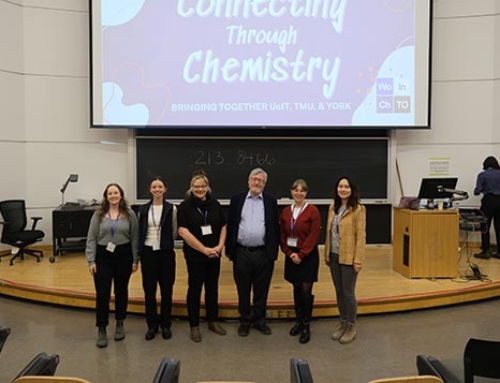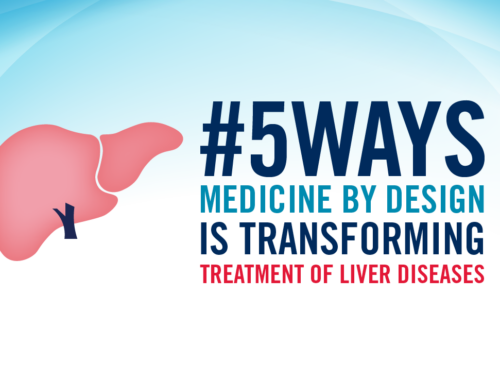
Shaf Keshavjee, left, Surgeon-in-Chief at University Health Network, and Tom Waddell, head of the Division of Thoracic Surgery at UHN and chief executive officer of XOR Labs Inc., talk at the Medicine by Design symposium in November 2016. (Neil Ta photo)
A technology that could increase the number of lungs available for transplantation and a stem-cell based treatment that has the potential to reverse heart failure are both a step closer to reality after winning Medicine by Design Clinical Translation and Commercialization Awards.
The projects, which were selected by a panel of reviewers with expertise in stem cell biology, technology commercialization and clinical translation, will share a total of more than $400,000 to help propel them from the laboratory bench to the bedside. Both have secured matching funds from industry partners and will advance two of the 20 collaborative team projects Medicine by Design announced in August 2016.
“Canada is a global leader in regenerative medicine research,” said Peter Zandstra, executive director of Medicine by Design. “With these new awards, we are ensuring the breakthroughs we make here will make an impact sooner, benefiting patients and fuelling Toronto’s vibrant life sciences sector.”
Medicine by Design harnesses the University of Toronto’s (U of T) expertise at the convergence of physical and life sciences, engineering, mathematics and medicine to advance the frontiers of regenerative medicine and cell therapy. Funded by a grant from the federal government’s Canada First Research Excellence Fund, the initiative comprises more than 90 principal investigators and hundreds of graduate students and post-doctoral fellows from U of T and its affiliated hospitals.
Shaf Keshavjee, Surgeon-in-Chief at University Health Network (UHN) and a professor of thoracic surgery at U of T, leads a team that is advancing a technology that enables surgeons to better assess and support the transplantability of donated lungs. Known as ex vivo lung perfusion, or EVLP, it involves placing the lungs in a protective dome, intubating them and preserving them at normal body temperature, allowing them to continue to function outside the body. Since UHN introduced this technology clinically 8 years ago, it has increased the percentage of donated lungs that are deemed healthy enough to transplant by 30 per cent. The current Toronto EVLP system is complex and restricted to operating rooms in large hospitals, requiring a large amount of space and technical expertise to run.
Keshavjee’s team will use the Medicine by Design award to develop a mobile version of the Toronto EVLP system that will not only simplify the process and allow doctors to start assessing donated lungs earlier, but also enable them to scale up and propagate their technology to transplant centres around the world.
“The mobile system we are developing has the potential to further increase the percentage of donated lungs we can transplant in North America to an unprecedented 50 per cent or more,” said Keshavjee. “This award from Medicine by Design offers crucial support that will enable us to move our technology into clinical trials more quickly, allowing for more life-saving transplants on patients with end-stage lung disease.”
Toronto-based biotechnology company XOR Labs Inc., which in September announced a new round of financing totalling $2.85 million (Canadian), is the industry partner for this project.

Michael Laflamme will use his Medicine by Design Clinical Translation and Commercialization Award to advance his pioneering techniques to treat heart failure.
Michael Laflamme, a senior scientist at the Toronto General Research Institute and the McEwen Centre for Regenerative Medicine at UHN and an associate professor in U of T’s Department of Laboratory Medicine and Pathobiology, will use his Medicine by Design award to advance preclinical testing of his pioneering techniques to repair damage caused by heart attacks using heart muscle cells grown from stem cells. Laflamme has already successfully transplanted these cells in other animal models, but will now test the safety and efficacy of the therapy on miniature pigs whose hearts are structurally and functionally similar to human hearts, a crucial step toward clinical trials and commercialization.
Laflamme and collaborator Gordon Keller are the regenerative medicine “dream team” that, with CCRM, drew Bayer AG and Versant Ventures to Toronto on Dec. 12 to announce the creation of BlueRock Therapeutics, a $225 million (U.S.) company based in Toronto, Boston and New York that is aimed at bringing stem cell-based therapies to market. Keller, director of the McEwen Centre for Regenerative Medicine and a professor of medical biophysics at U of T, is a leading expert in growing different types of heart cells from stem cells. Laflamme is at the forefront of developing techniques to transplant these cells safely and effectively to reverse heart failure. Medicine by Design has supported their research through both Team Project Awards and the transitional funding it distributed shortly after its creation in 2015. Additional support has been provided by the Ontario Institute for Regenerative Medicine and the McEwen Centre.
“More than 50,000 Canadians are diagnosed with heart failure each year,” said Laflamme. “This new funding from Medicine by Design will accelerate our timeline to clinical trials by helping us demonstrate the feasibility of our approach to regenerating heart muscle and unlocking new commercialization opportunities with BlueRock. It will also provide a platform to test future cell products that emerge from our work.”
Commercialization experts said Medicine by Design is a key pillar of Canada’s emergence as a global centre for stem cell research and commercialization.
“Medicine by Design is the research engine that is driving Toronto’s burgeoning regenerative medicine sector,” said William Mitchell, a professor of strategic management at the Rotman School of Management and a member of the review panel. “Along with CCRM, the Rotman School, industry partners and investors, this transformative initiative is at the heart of a vibrant ecosystem that is positioning Canada to lead the world in cell therapies.”
“Announcements, like the one for BlueRock Therapeutics, are exactly what CCRM has been working towards for the last five years,” said Michael May, president and CEO of CCRM, Medicine by Design’s commercialization partner. “Right now, Toronto is on everyone’s radar and there’s a spotlight on the exciting regenerative medicine science happening at Medicine by Design and in other Canadian institutions. CCRM is pleased to be playing its part in helping to advance these innovative technologies and commercialize these revolutionary therapies.”






